Jackson Mark. Machining with Abrasives
Подождите немного. Документ загружается.

l
Increasing fluid density, r
f
, reduces particle velocity.
l
Increasing fluid viscosi ty, m
f
, is beneficial, provided pressure losses inside the
mixing tube are not excessive.
l
For AWJ, maximizing the abrasive flow rate is always beneficial, as long as the
fluid to abrasive flow ratio
_
m
f
:
_
m
p
is maintained under 50:1.
l
Changing abrasive particle size, within the limits in (9.13), at a constant abrasive
flow rate, alters the number of abrasive particles per second, but does not change
the total energy stored, nor average particle velocity, v
pr
.
l
Only very short mixing tubes lead to reduced particle velocity. At the typical
L/d 300, the effects of tube length and particle size cancel out.
A typical commercial AWJ system, similar to Fig. 9.1 , uses a 0.25 mm orifice,
D ¼ 0.75 mm and L ¼ 75 mm mixing tube, filtered water, and garnet abrasives.
For such a system, (9.13) becomes
v
pr
0:025
ffiffiffiffiffi
P
i
p
1 e
1=480d
& d
ffiffiffiffiffi
P
i
p
b4:8; (9.14)
which is a more accur ate estimator
_
m
w
=
_
m
p
b50than (9.11). At 400 MPa, and
provided that nominal particle size d < 0.24 mm and, then the average particle
velocity at the instant of impact is v
pr
500 m/s. This result and the closed-form
solution in (9.13) are in agreement with the numerical estimation in [57] and other
analytical and experimental results [58], but it is simpler and more intuitive to use.
9.2.4 Research Directions
A proper analysis of AWJ or AAJ would require the solution of a number of
coupled partial differential equations for the three-phase fluid dynamics of a
mixed flow of water, air bubbles (for AW J; or air with moisture content, for AAJ)
and solid abrasive particles; along with the contact and impact solid dynamics
among the particles, and between particles and the mixing tube wall; plus
thermodynamics and heat transfer, multi-body kinematics, and statistical mechan-
ics. The fluid dynamics is viscous compressible, rotational, entropic, turbulent,
mixed-phase with moving, deformable, discontinuous, and randomly-moving
boundaries. The solid dynamics involves elastic-plastic multi-b ody collisions,
fracture, fragmentation, and all sorts of constitutive materials behaviors; and subject
to random body motions and weakly defined boundary conditions. Al l those
behaviors are coupled in an exceedingly nonlinear manner that precludes the
possibility of any closed-form solution, even in some statistical sense. It is safe to
say that a problem like AWJ is not solvable, from first principles of continuum and
statistical mechanics. Even with current advances in computational methods, and the
exponential growth in computing power and high-performance computers, this
problem remains a challenge, and there may be decades before it can be simulated
numerically with satisfactory realism.
9 Impact Abrasive Machining 395
Efforts towards more advanced analysis of jet generation and characteristics are
a huge volume of research, as reviewed in [37, 59], and include:
l
Development of high-pressure equipment and systems;
l
Optimization of orifice and nozzle design and alignment;
l
Characterization of abrasives size, shape, and velocity distribut ions;
l
Estimation and minimization of pressure drop, energy and momentum losses,
and other inefficiencies during the mixing process;
l
Particle acceleration models, similar to that in (9.13);
l
Particle fragmentation and size reduction; and
l
Wear of the mixing (focusing) tube and its effect on jet characteristics; to name
but some of the research topics. Most of those issues are relevant to machine and
nozzle design. Once a specific machine or cutting head is selected, those para-
meters cannot be altered. Hence, for production and process planning of AWJ,
(9.13) remains a more useful model of controllable process variables.
There are significant efforts to simulate the jet flow using Computational Fluid
Dynamics (CFD). These include [59–61] solv ing the 2D axi-symmetric problem for
the axial and radial velocity distributions of the fluid jet, then fitting the numerical
solution to an equation, which is then used to estimate particle velocity. Similar
treatments were reported in [62, 63]. In [64] random position and velocity of
particles were simulated by mean of a fractal point set, without physical justifica-
tion why abrasive jets may have a fractal dimension, or why their motions follow
any specific statistical distribution. Further, at the current state of computational
abilities, it is still difficult to simul ate the multi-physics of the coupled motion of
both fluid and particles, as they interfere with the behaviour of each other in a
highly nonlinear manner.
There have been extensive efforts in developing techniques for experimental
measurement of pure waterjet and abrasive particle velocity inside the AWJ [37] and
AAJ [56]. Techniques include magnetic and inductive methods, reverse estimation
from impact crater depth or from impact force measurement, various types of laser
(interference, time of flight, or Doppler) velocity meters, or using ultra-high speed
photography. All techniques include measurement uncertainties, difficulties in
discriminating between fluid and particle, and they only detect average behaviour
outside the nozzle, i.e. not the axial and radial distributions inside the nozzle. Results
from experimental measurements are in agreement with (9.13).
9.3 Material Removal by Impact
In a typical AWJ machine, abrasive particles mass flow rate could be ~10 g/s. For
garnet particles, and nominal average size ~0.15 mm, this amounts to ~10
6
particles
per second; which may seem a huge number, but it is only one particle per
microsecond. At impact velocity ~500 m/s, the full process of particle indentation
and rebound lasts a fraction of ms. The jet spreads over ~1 mm spot size, ~40 the
396 Y.M. Ali and J. Wang
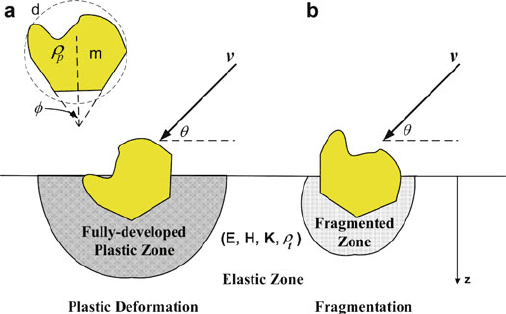
area for a single particle impact. Traverse (workpiece displacement) speed is
typically 1–100 mm/s, whi ch is negligible compared to impact velocity, and only
fraction of a mm/ms – which is negligi ble compared to particle size.
From this quick calculation, it is reasonable to treat AWJ as a sequence of single-
particle impacts: each particle indents, removes material, and rebounds away from
the target as an independent event, without interference from other particles or from
workpiece motion. The final effect of an AWJ cut is the geometric superposition of
craters produced by all particles. This may not be simple to calculate due to the
random variation in particles sizes, shapes, and times of their arrival at particular
spots on the target. There may also be interference among incoming and rebounding
particles, removed debris, or the waterjet. However, it should be possible, in
principle, to develop an average model to account for all those perturbations, if
the effect from single particle impact is known with reasonable confidence.
In AWJ, all forms of irregular particle shapes can be found in the abrasive jet.
Rigid body rotation of the particles inside the jet stream, sliding and rolling motion
during impact on the target, and localized deformation and fragmentation of the
particles during impact, all provide additional uncertainty. It is not possible to
estimate the distribution of real particle geometries at the instant of impact on the
surface. It is assumed that all those random effects balance, and some “average”
abrasive particle behavior is modeled by spherical impact. The main advantage of
such assumpt ion is that the contact mechanics of a sphere is one of the most studied
and understood [65–69].
In general, material response to impact is described either as ductile or britt le
erosion, as shown in Fig. 9.4. Ductile erosion is relevant to metals and similar
materials that are capable of significant plastic deformation. Brittle erosion applies
to ceramics, glasses, and hard metals that crack and fragment under impact.
Fig. 9.4 Ductile and brittle erosion modes
9 Impact Abrasive Machining 397
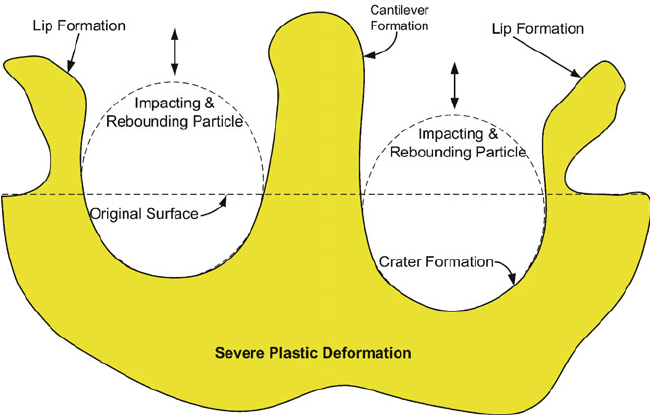
9.3.1 Ductile Erosion
Considering a rigid particle hitting a smooth flat surface, as shown in Fig. 9.4, the
general oblique impact condition can be decomposed into normal (indentation-like)
and tangential (scr atching-like) components. For normal impact, y ¼ 90
, the
particle pushes the surface down, and material beneath is compressed. As indenta-
tion continues, material in the high compression zone escapes pressure, by moving
sideways, then upward towards the free surface. After the particle rebounds, a
permanent crater is left on the surface, and excess lips (elongated flakes) are
formed. The successive application of numerous particles results in cantilever
formations that are easy to separate from the mother material (Fig. 9.5).
If an abrasive particle has mass, m
p
, and initial impact velocity, v, its stored
kinetic energy is ½ m
p
v
2
. Upon impact on the target surface, some fraction of the
kinetic energy is consumed in displacing the target surface and forming a perma-
nent crater, such that [1]
m
p
ðvsinyÞ
2
/
Z
h
0
HAðxÞdx; (9.15)
where H is target material hardness, and h is indentation or crater depth. The
projected area function, A(x), is unknown, except for some regular shapes. However,
exact expre ssion for that function is not required, by noting that crater volume, V,is
Fig. 9.5 Material displacement and removal by successive particles impact
398 Y.M. Ali and J. Wang
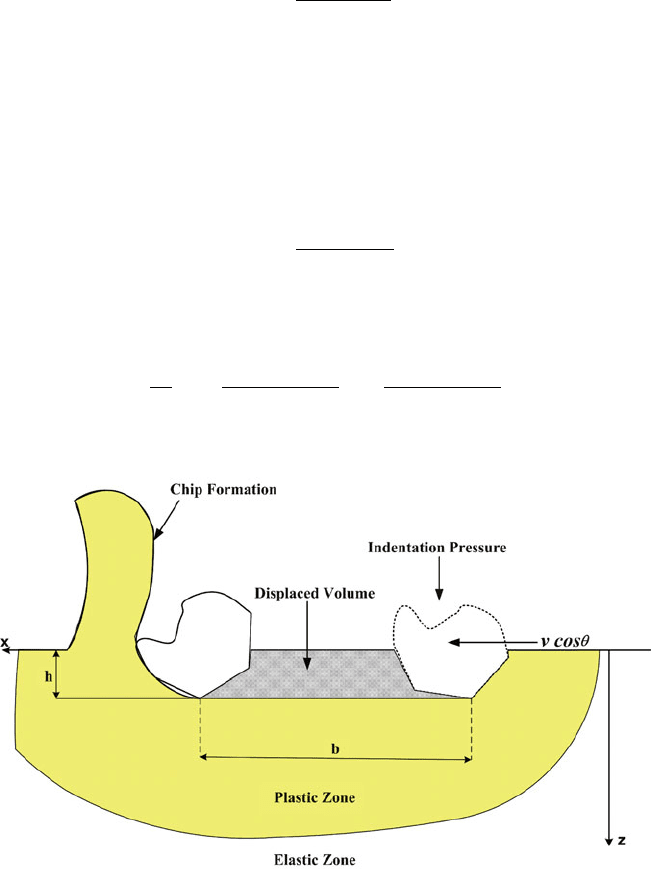
V ¼
Z
h
0
AðxÞdx: (9.16)
Consequently, the volume removed by impact, V
r
,is
V
r
/
m
p
ðv sin yÞ
2
H
; (9.17)
which is a relative estimate of material removal in ductile materials by normal
impact.
During tangential (scratching) motion, as shown in Fig. 9.6, shear stresses increase
at the expense of compressive stresses. Stresses become tensile on the trailing edge
and more compressive on the leading edge of the particle. Crater formation includes
the ploughing effect from sliding and friction. The volume removed in this case, as in
(9.17), is also proportional to the kinetic energy of the particle:
V
r
/
m
p
ðv cos yÞ
2
H
: (9.18)
The combined volume removed due to oblique impact is obtained by addition of
the normal and tangential components:
V
r
m
p
¼
k
n
ðv sin y
v
n
Þ
2
H
þ
k
t
ðv cos y
v
t
Þ
2
H
(9.19)
Fig. 9.6 Material removal by tangential (scratching) abrasive motion
9 Impact Abrasive Machining 399
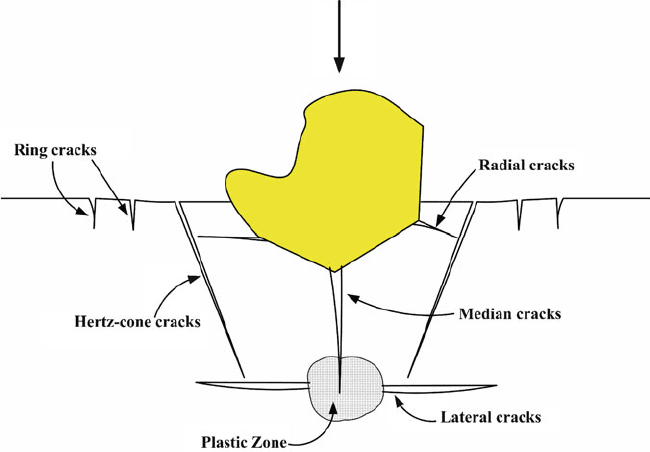
where k
n
and k
t
are experimental coefficients, and v
n
and v
t
are threshold velocities
below which no material removal can occur. The erosion model in (9.19) is similar
to that proposed by Neilson and Gilchrist [70], which is a generalization of earlier
erosion models by Finnie [71] and Bitter [72, 73]. There are many other ductile
erosion models, e.g. [74], as reviewed in [31].
9.3.2 Brittle Erosion
When a target material is not capable of significant plastic deformation, it responds
to impact loads by fracture, forming cracks, and fragmentation of the affected zone.
Cracks can be of the ring type (due to elastic stress waves [75]), conical type (due to
quasi-static tensile failure [76]), radial, median, and lateral type (due to stress
redistribution in the plastic zone at the crack-tip during loading and unloading)
[77–79], as shown in Fig. 9.7. The estimation of those brittle fracture mechanisms
require some assumptions about flaws sizes and their distribution; the location, size,
and growth rate of the various cracks; and the interactions among various cracks.
Such models eventually resort to experimental data for quantitative verification.
All brittle erosion models can be reduced to a causality formula of the form:
V
r
/ r
q
1
p
d
q
2
v
q
3
H
q
4
K
q
5
E
q
6
; (9.20)
Fig. 9.7 Brittle erosion by cracking and fragmentation
400 Y.M. Ali and J. Wang

where r
p
is particle density, d is particle size, v its impact velocity, and H, K and E
are hardness, fracture toughness and Young’s modulus of the target material,
respectively. Depending on the specific fractu re model being assumed, the expo-
nents in (9.20) are found to be: q
1
¼ 0–1.6, q
2
¼ 3–4.2, q
3
¼ 2–3.2, q
4
¼ –1.4 to
1, q
5
¼2to1, and q
6
¼ 1–1.25. For quantitative accuracy, it is appropriate to
evaluate those exponents experimentally for each specific particle-target materials
combination.
9.3.3 Unified Erosion Model
It is noted that all ductile erosion models, e.g. (9.19), predict that V
r
/ v
2
, while
brittle erosion models, e.g. (9.20), predict that V
r
/ v
3
. This is in disagreement with
experimental observations, where it is found that the velocity exponent is dependent
on material property, and is 2.2–2.5 for metals and 2.6–3 for ceramics. The
deviation between models and experiment is understood, because of the fact that
no real material is absolutely ductile or absolutely bri ttle, and some interpolation
between the two extreme idealizations is needed. As impact velocity is the most
important variable in impact erosion, error in estimating the velocity exponent can
degrade the accuracy of all those models.
Further, it is observed that maximum erosion occurs at an impact angle, y
max
,of
near 90
for brittle materials at higher velocity or using coarser abrasive particle
(Fig. 9.8). The peak erosion angle is 20–30
for ductile materials at lower impact
velocity or using finer particles. The above models are unable to explain this peak
shifting. As impact angle is the second most important factor affecting material
removal, this represents an added source of inaccuracy.
In a yet to be published work, the authors present a unified erosion model that is
applicable to ductile and brittle materials alike. It is able to interpolate between the
extreme cases of ideal plasticity and ideal fracture, and provide a more realistic
representation of real engineering materials. The model can explain the variable
velocity exponent, the peak erosion angle shifting, the effect of various material
properties, the effect of particle size and shape, and other effects such as ductile-
brittle transition and size effect. According to such a model
V
r
m
p
¼ðA
1
sin
2
y þ A
3
cos
2
yÞv
2
þðA
2
sin
3
y þ A
4
cos
3
yÞv
3
; (9.21)
where
A
1
¼ k
1
10
4
D
a þ bH
; A
2
¼ k
2
ð1 10
4
DÞ
d
2HD
2
3=2
; A
3
¼ A
1
k
3
k
1
; A
4
¼ A
2
k
4
k
2
;
D ¼
K
ffiffiffiffiffiffiffiffiffiffiffiffiffiffiffiffiffiffiffiffiffiffiffiffiffiffiffiffiffiffiffiffiffi
2EHð1 þ 2e
f
=e
e
Þ
p
; (9.22)
9 Impact Abrasive Machining 401
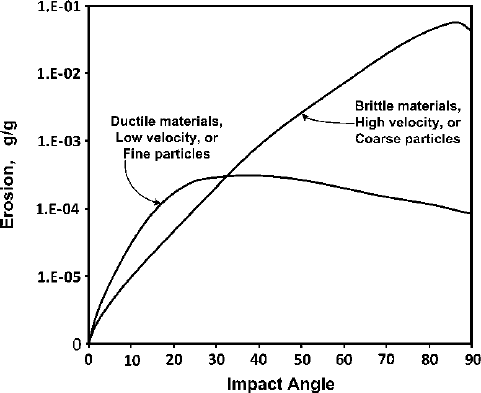
a and b are material constants relating dynamic to quasi-static hardness, e
f
and
e
e
are fracture and elastic strains (material properties of the target material),
and k
1
–k
4
are experimental parameters. For specific abrasive particle-target mater i-
als combinations, it is better to use (9.21), with A
1
–A
4
determined experimentally.
9.3.4 Material Removal by Abrasive Jet
For ductile materials, Hashish [80] proposed an AWJ machining model based on
the initial Finnie model [71]. This was later improved [81] based on the revised
model by Finnie and Sheldon [82]. Numerous models (e.g. [83 – 85]) have been
proposed over the years, and they are all fundamentally similar, and are based on
some modification of ( 9.19). For brittle materials, various models for AWJ machin-
ing have been proposed (e.g. [86–88]), and they are all based on the quasi-static
fracture models developed in [77–79], as generalized by (9.20). All such AWJ
machining models are subject to limitations imposed by their parent impact erosion
models, as discussed in Sect. 9.3.3. Specifically, these models cannot predict the
material-dependent velocity exponent, erosion peak angle shifting due to particle
size, nor the ductile-brittle transition experience in real material behaviour,
e.g. Fig. 9.8.
The average velocity of the abrasive particle, as it exits the nozzle, can be
estimated from (9.13). The average target material removal due to impact by the
abrasive particle can be estimated from (9.21). For a jet stream containing
Fig. 9.8 Peak erosion angle shifting with material and impact conditions
402 Y.M. Ali and J. Wang

numerous abrasive particles, it is suitable to take the time derivative of (9.21), and
express the material removal rate per abrasive particle mass flow rate, as
E ¼
_
V
r
_
m
p
¼
dDU
_
m
p
; (9.23)
where d is depth of cut, D is nozzle diameter (approximately equal to width of cut,
for small standoff distance), and U is traverse speed of the jet on the surface of the
target material. Typical removal rates usin g AWJ cutting are listed in Table 9.2.
For a given nozzle diameter and abrasive flow rate (as defined in Sect. 9.2.3), it is
seen that volume removal rate is conserved. There is direct trade-off between depth
of cut and traverse speed: increasing traverse speed decreases the depth of cut. The
only way to increase depth of cut at constant traverse speed, abrasive flow rate, and
nozzle diameter is by increasing the erosion rate itself, as dictated by (9.21). For a
given target material, maximizing erosion is achieved by either maximizing the
impact velocity, v in terms of (9.13), or by selecting the optimum impact angle for
peak erosion, as in Fig. 9.8.
Using (9.23), it is possible to estimate a typical depth of cut due to AWJ, using
any jet parameters, and for any target material. Real material removal by AWJ is
more complicated than described above. As the AWJ traverses across a target work-
piece, a kerf is gradually developed. This process was extensively studied using
high-speed camera visualization techniques [89, 90], and is outlined in Fig. 9.9.
Initially, abrasive particles impact normal to the workpiece surface, and material
removal is similar to Fig. 9.5. However, as the jet proceeds and some material is
removed, a ramp is formed: abrasives then approach tangential impact as in
Fig. 9.6. As the jet continues its traverse, a step is formed, and a condition of
normal impact is restored. The cycle continues repeatedly, until a steady state
condition is reached; a kerf profile, having a step-wise ramp shape, is maintained
for the rest of the cut.
As can be seen from the right-most view in Fig. 9.9, under steady state conditions,
some particles impact on the material at near normal (indentation-like), while other
impact at near tangential (scratching-like) direction. For historic reasons, Hashish
[80, 89] refers to the first condition as “deformation wear” and to the latter as “cutting
wear”. In reality, material is removed during both cases, but the mechanism varies, as
shown in Figs. 9.5 and 9.6. The importance of kerf formation can be understood from
inspection of Fig. 9.8. It is seen that material removal rate is maximized for brittle
Table 9.2 Typical removal rates by AWJ for depth d ¼ 25 mm
Material
Speed,
U (mm/s) Material
Speed,
U (mm/s) Material
Speed,
U (mm/s)
Carbon steels 0.5–2 Aluminum 0.3–3.5 Glass 35
Alloy steels 0.2–1 Titanium 0.2–2 Quartz 0.3
Stainless steels 0.2–1.5 Nickel alloys 0.04–0.15 Alumina 0.05–0.3
9 Impact Abrasive Machining 403

materials when particles impact near normal. For ductile materials, material removal
is maximized when particles impact at 20–30
to the surface.
The geometry in Fig. 9.9 results in particles impacting at angles whose average is
the optimum angle for neither ductile nor brittle materials. At present, there is no
satisfactory theory to estimate the equivalent average impact angle and kerf formation,
in terms of process variables. However, from geometry, the kerf can have a steeper
ramp when the traverse speed is lower. This, in turn, reduces the average impact angle,
and brings it closer to the scratching mode. Therefore, it is more efficient to cut ductile
materials at slower traverse speed (smaller effective impact angle), while faster
traverse speed (larger effective impact angle) is more productive for machining
brittle material. However, as seen from (9.23), there is interdependence between
traverse speed and depth of cut. A better alternative to enhance (and control) the
effective impact angle by tilting the nozzle, as will be explained in Sect. 9.4.1.
From the circular cross-section of the jet, it is clear that more abrasive particles
impact near centerline of the cutting path than near its edge. Moreover, there is
greater loss of kinetic energy near edge of the jet, due to abrasive particle deflec-
tions, inter-particle collisions during rebound, and interference from the fluid jet.
This results in tapering of the cut groove, as shown in Fig. 9.10, and the final cut can
be divided into three distinct zones [91, 92]:
l
Smooth cut zone: where the tapering effect is relatively small and surface
roughness of the produced wall is reasonably fine.
l
Rough or striation cut zone: where the tapper angle is significantly larger, and
significant scratch marks and rough wall surface is observed.
l
Pocket formation: where material removal is due to random colli sions from
rebounding particles.
Fig. 9.9 Step formation during abrasive jet traverse
404 Y.M. Ali and J. Wang
